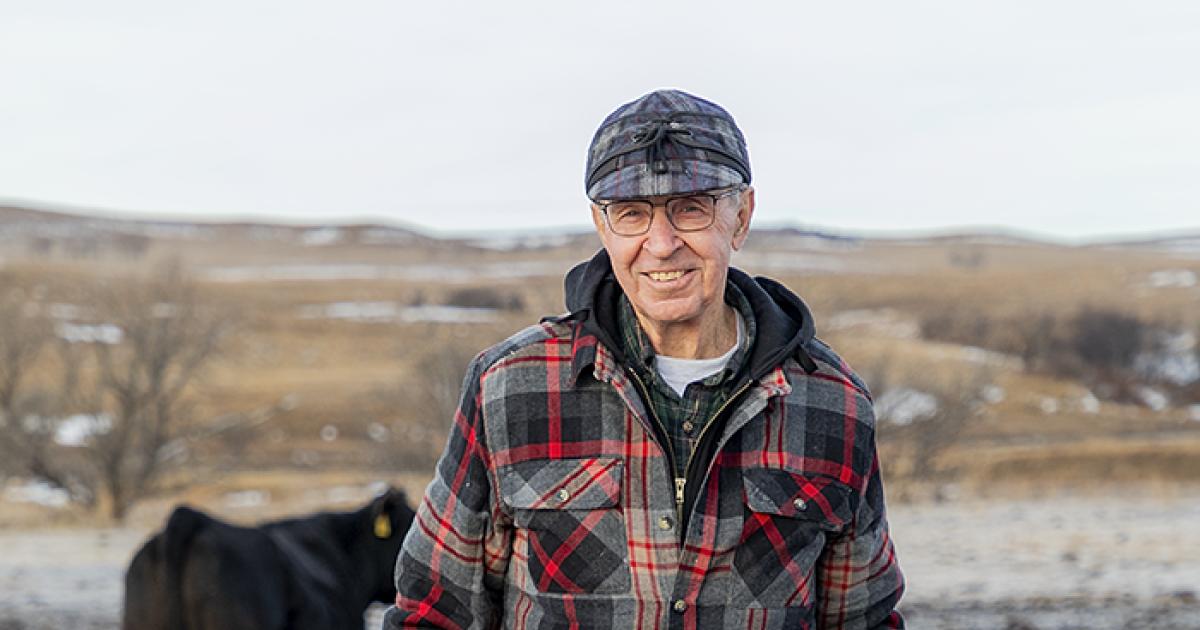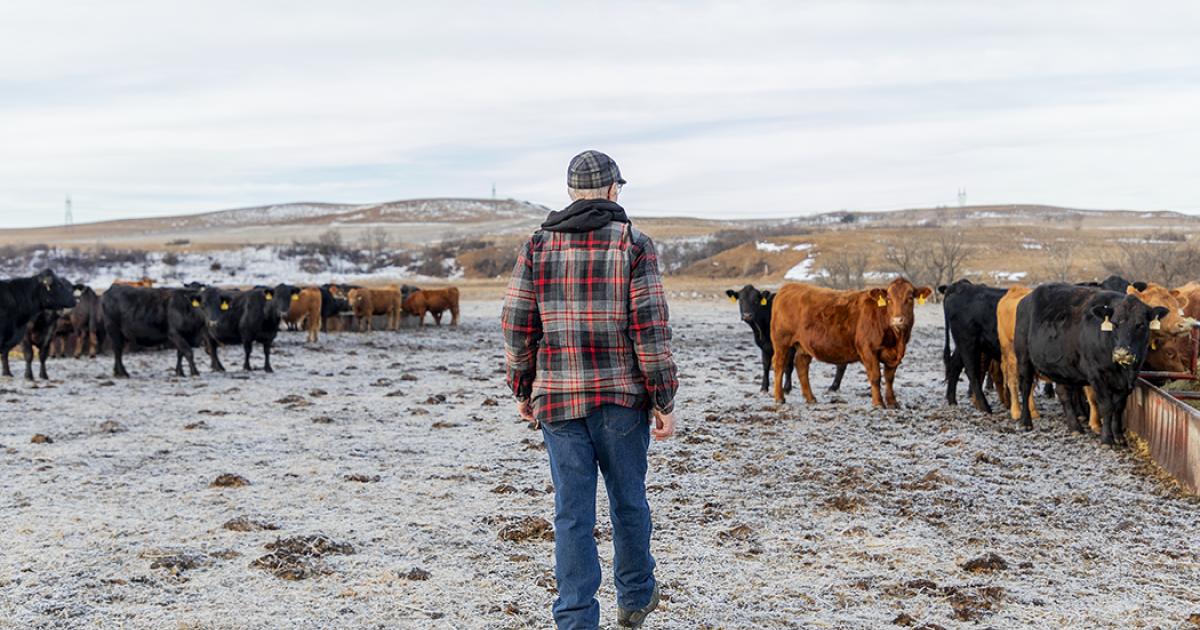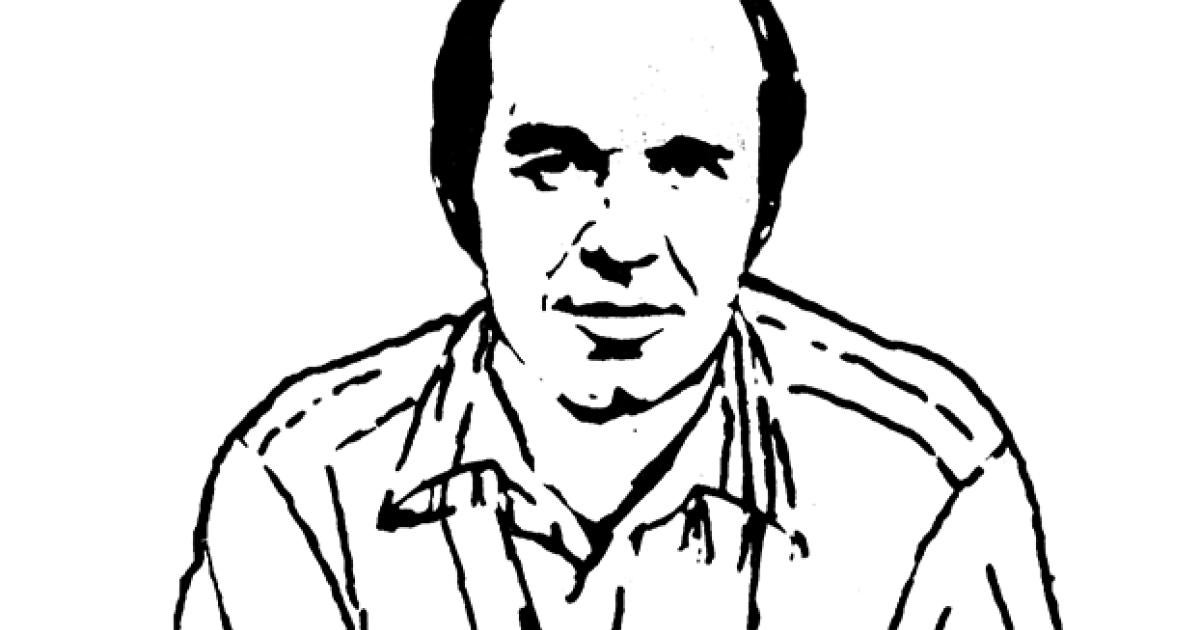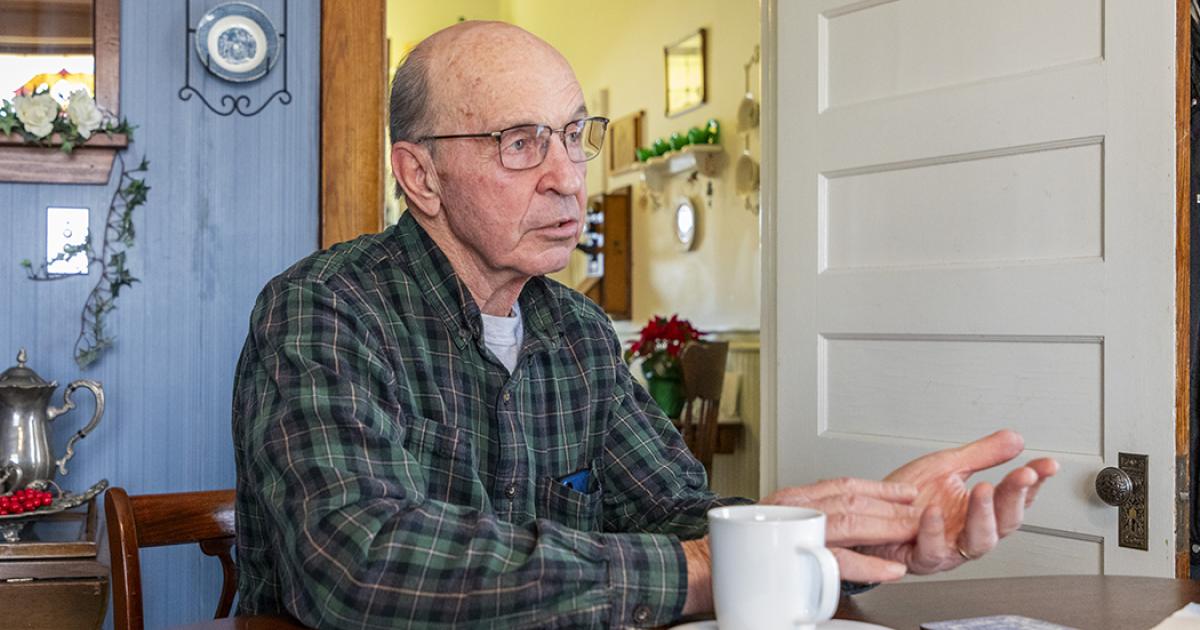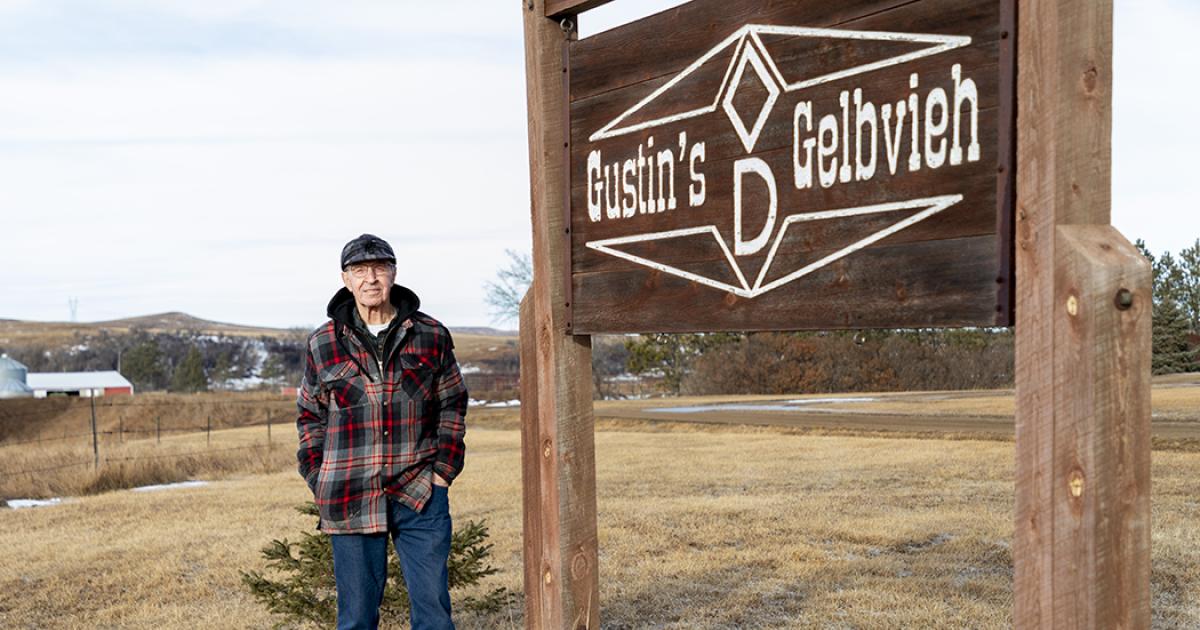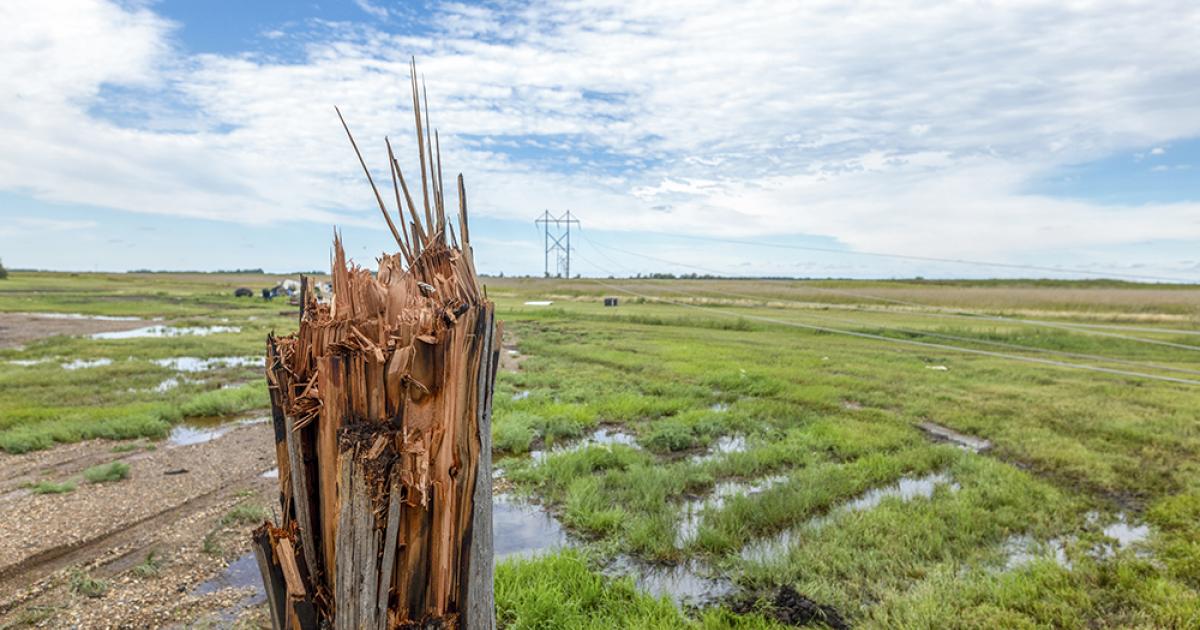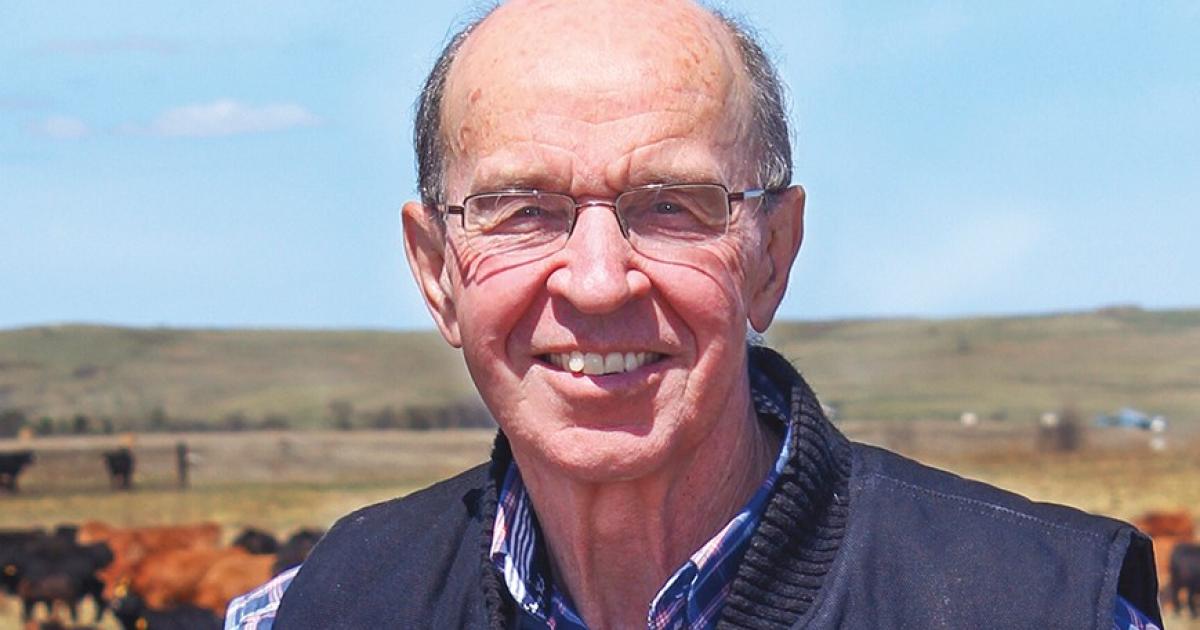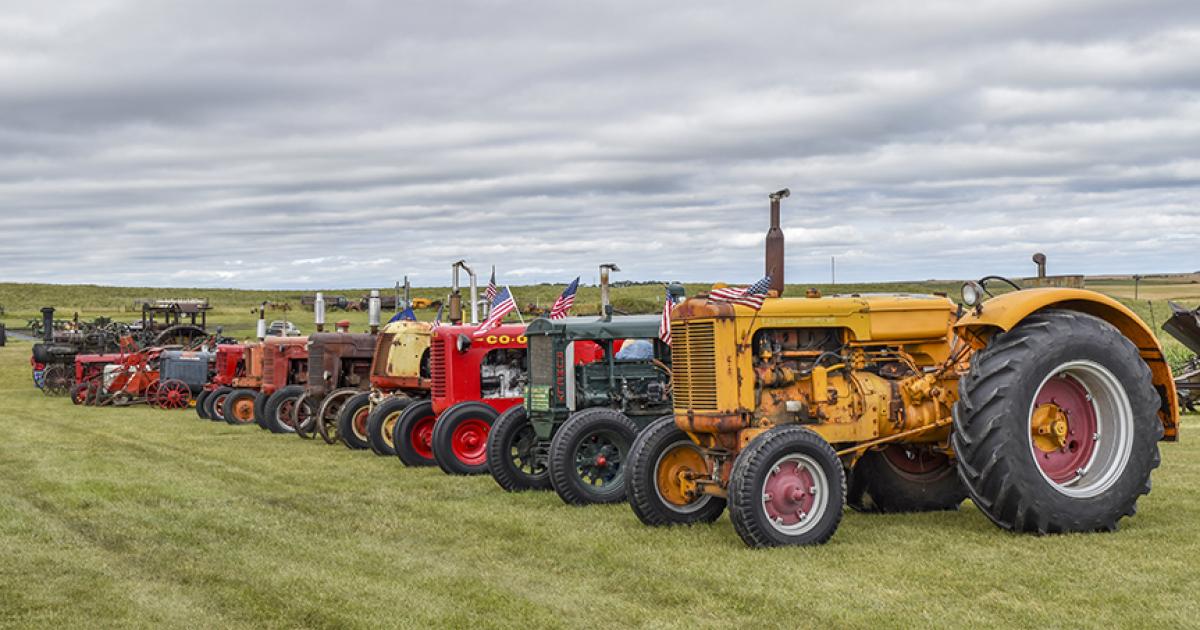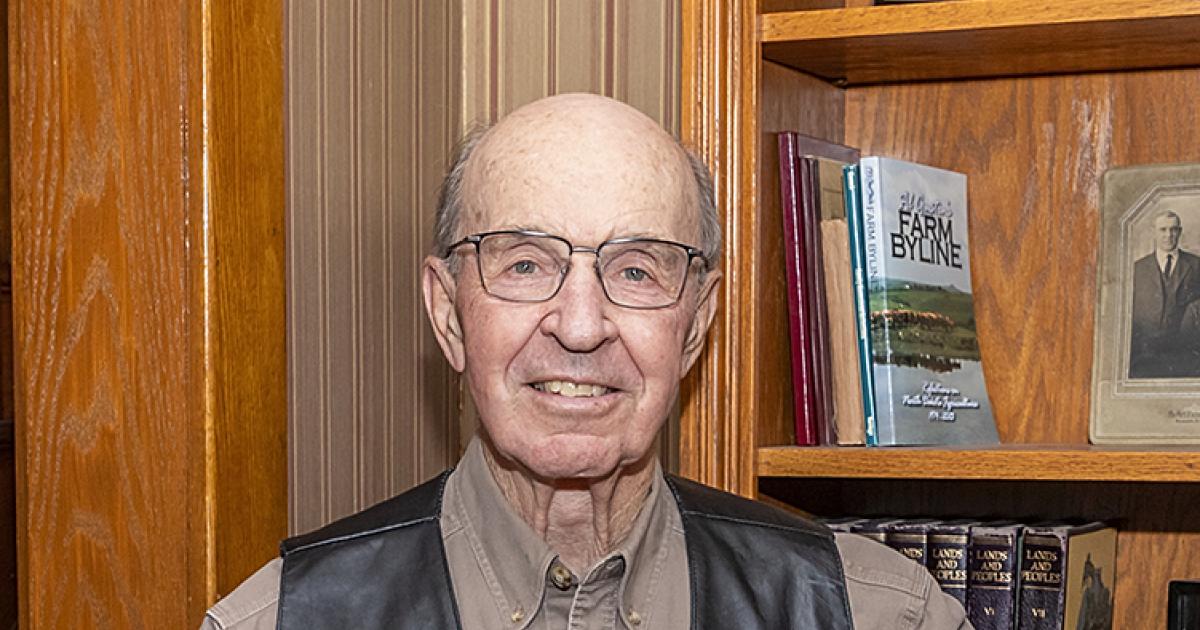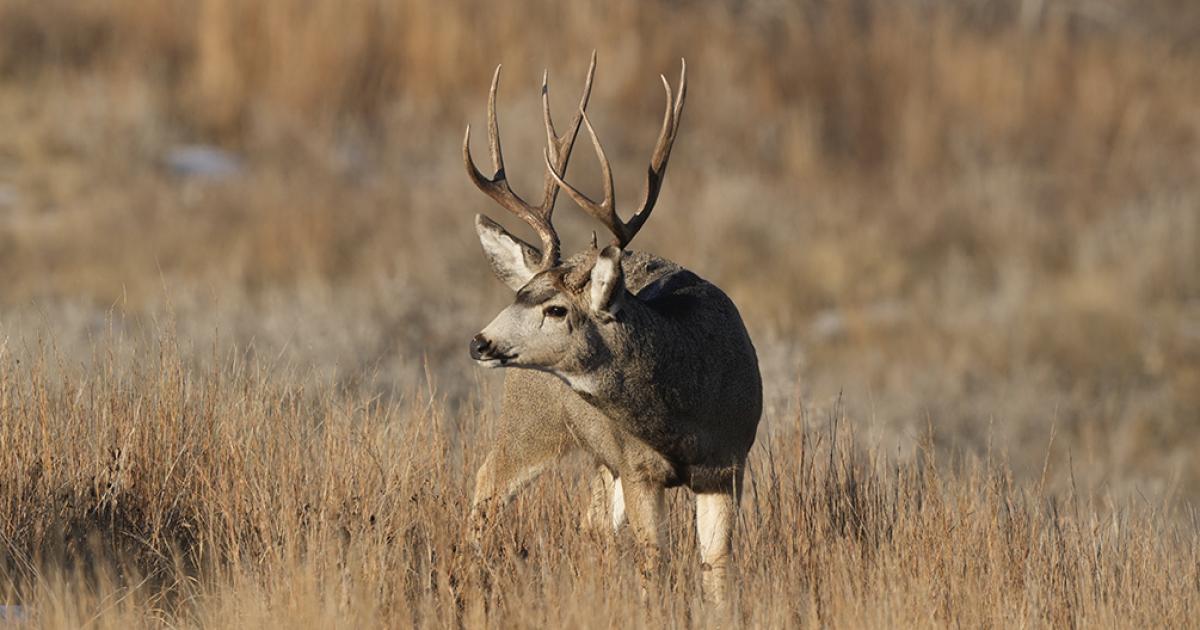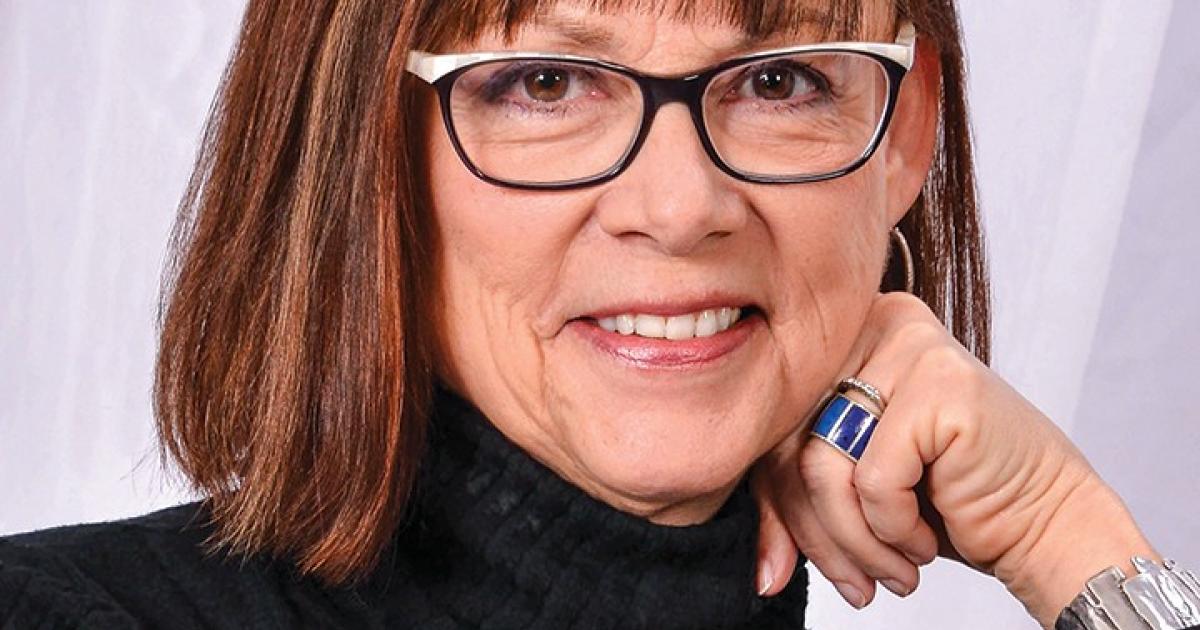Gustin writes ag column for 50 years
“He loves his cattle,” Peggy says of her husband, Al Gustin, who raises Gelbvieh cattle alongside his brother, Dennis, on the Gustin family farm and ranch south of Mandan. Docility is a strength of the Gelbvieh breed, Al says. Photos by NDAREC/Liza Kessel
“Hey, girls. Hey, girls,” Al Gustin gently calls to the cows during morning chores, reassuring them in the presence of strangers holding a camera, notepad and pen.
The cows recognize his voice. The people do, too.
For 45 years, the retired farm broadcaster was the first welcomed guest in homes and on farms across North Dakota as he delivered his trusted morning ag news. And in January, Gustin completed his 50th year writing his monthly column, “Farm Byline,” in North Dakota Living.
Gustin stops to pat 12C, a black Gelbvieh he owns.
“She’s such a super cow,” he says.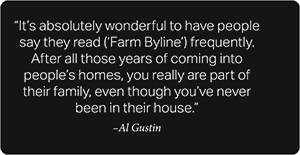 Winter’s frozen ground crunches beneath his feet, and for a moment, the one holding the notepad and pen recognizes herself as an intruder on what must be a highlight of Gustin’s day. Is this where he contemplates his next “Farm Byline?” Is this where he shut off the noise of broadcasting? Is this his place of peace and relative quiet, with its mooing choir?
Winter’s frozen ground crunches beneath his feet, and for a moment, the one holding the notepad and pen recognizes herself as an intruder on what must be a highlight of Gustin’s day. Is this where he contemplates his next “Farm Byline?” Is this where he shut off the noise of broadcasting? Is this his place of peace and relative quiet, with its mooing choir?
Here, the Missouri River bluffs paint the backdrop for the Gustin family farm south of Mandan, where Gustin has farmed and ranched alongside his brother, Dennis, who manages the operation, ever since their father died in 1976.
This is the place to learn who Al Gustin is and to understand his connection to the land that has informed his lifetime of writing and reporting in rural America.
“You think of all the millions and millions of people whose parents, grandparents and great-grandparents were all in New York City. They have no idea – no idea – what it’s like to be part of the land,” he says. “For us, it’s part of us. It’s who we are.”
“In every state, there are people who have that same connection to the land, but it certainly changes your perspective, I think, as far as how we look at things and what you think is important, and the need to preserve it,” he says. “We don’t own it. We are stewards of it. … It’s ours to take care of, and so I think that does help define us, when we have that connection to the land.”
WRITING THE ‘FARM BYLINE’
Al’s first “Farm Byline” appeared in the February 1974 issue of North Dakota Living, formerly the North Dakota REC Magazine.
“What I thought about most as I read that first column,” Al writes in a recent reflection, “was why a magazine like this would think this young kid, just a few years out of college, would have something to say worthy of a monthly column. It’s true, because of my job, a lot of farmers and ranchers thought I was an expert (which I wasn’t) and the job offered me a pulpit of sorts to comment on issues I felt needed commentary.”
Whether he was an expert or not, people trusted him. Being an active farmer and rancher himself provided the credibility to speak to farmers and ranchers, and on behalf of farmers and ranchers, on matters important to farmers and ranchers. In delivering his monthly columns, Al feels a responsibility to educate and inform on agriculture.
“In spite of what some people hear or see on social media, we’re doing a better job today of conservation. We’re doing a better job today of stewardship of our livestock. … It bothers me that we hear this criticism, of farmers and ranchers ‘raping the land’ and ‘poisoning the ground with all these chemicals’ and all that… It’s not true and somebody needs to say that,” he says.
One of the more difficult aspects of writing an ag column for 50 years, Al says, is maintaining relevancy with electric co-op members and the North Dakota Living audience.
“The people who were members of rural electric cooperatives when I started, they were virtually all family farmers, and now a significant percentage of people who get the magazine aren’t farmers at all,” he says. “They’re living on the outskirts of Bismarck and Mandan and Dickinson, and just because they’re on a rural electric system, they maybe have little or no connection to agriculture, so can they relate to what I write?”
“Sometimes, I write something my farmer and rancher readers are going to think, ‘This is really basic, and everybody knows this,’ but then you have to sit back and think there’s a whole lot of other people out there that don’t know,” he says.
Meeting a deadline each month for 50 years hasn’t been a problem for the veteran journalist. Whether it’s reading a farm magazine, hearing something on the news or pulled from the many conversations he has with producers, neighbors, friends and readers, Al’s laundry list of “Farm Byline” topics are always percolating.
“Initially, I wrote about a lot of things as I recall, but it sort of gravitated to my reflections on how things have changed, and in some cases how things have not changed,” he says. “Sometimes, I dig through a lot of old stuff to make sure what I remember is right.”
“When you get old, you forget a lot of things that happened and remember some things that never happened,” Al says with a laugh.
His wife, Peggy, helps, too. She reads, edits, provides feedback and asks for clarification, when needed, before Al submits his monthly magazine columns.
“She’s my best critic,” he says with a smile.
And his north star.
“Just remember who you’re working for,” she’d remind him on tough days at the radio station. “You’re not working for them (those who wrote his paycheck), but you’re working for all the people out there that trust you, that rely on you, that count on you being there every day. That’s who you’re working for.”
What’s it like working for all those people? And meeting his readers, listeners and viewers?
“It’s wonderful, it’s absolutely wonderful,” he says. “After all those years of coming into people’s homes (through radio, TV or the magazine), you really are part of their family, even though you’ve never been in their house.”
IN AL’S HOUSE
The morning with Mr. Farm Byline ends with a tour of the Gustins’ immaculately restored 1883 home, which they found by placing an ad in North Dakota Living and moved to the farm from New Salem in 1991. Referred to as “New Salem’s first fine residence,” it was built by German evangelist James Lueck and was one of relatively few buildings in the town when President Theodore Roosevelt passed by rail on his first trip to the Badlands in 1883.
Adorning the walls are framed family pictures, including of their three daughters, grandchildren and the Germans from Russia ancestors who stewarded the land before them, old marriage certificates that look more like art and even a handwritten archive of all the babies ever born in the home, from when Mrs. Richard Wolf, a midwife, occupied it.
“I feel like I live in a museum,” jokes Al, who, alongside his wife, did most of the gutting, remodeling and restoration work.
Sitting down to visit over coffee and bars, it seems Al has welcomed these strangers into his home – and his life – in the same way families have welcomed him into theirs for more than 50 years.
Al recalls a recent visit with a stranger, whose name he found in some old files, then called him to discuss the Farmers Home Administration for a column in North Dakota Living. After the conversation, the stranger asked to get together sometime to “just talk about old times.”
“People think they really know you, even though they’ve never met you,” he says. “And I thought, isn’t this neat? He considers me a friend. And why? Why am I his friend? Is it because I’m writing or because I was on TV, or was it because of what I said as a broadcaster, or is it because of what I wrote as a columnist, that people would think I’m their friend? That’s really special. I’m honored to have that.”
___
Cally Peterson is editor of North Dakota Living. She can be reached at cpeterson@ndarec.com.
In 2013, Al Gustin published a book, which holds a collection of 162 of his columns from North Dakota Living. “Al Gustin’s Farm Byline: Reflections on North Dakota Agriculture, 1974 to 2013” is available for purchase online at www.DakotaBookNet.com or by contacting Gustin directly at algustin57@gmail.com or 701-663-1230.


